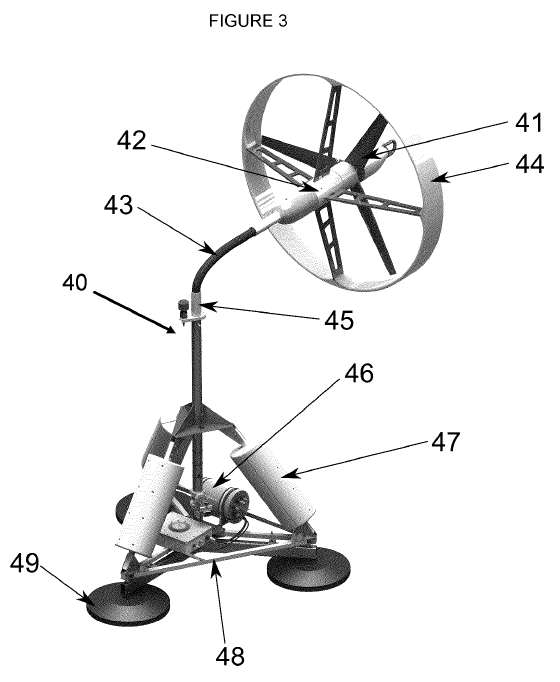- A new patent has issued to Memorial University of Newfoundland for an underwater turbine that rotates to self-orient with water current.
- Memorial University appears to have spun off a company to commercialize the patented invention.
New U.S. Patent No. 9,784,236 (the ‘236 Patent) issued on October 10th from the U.S. Patent and Trademark Office for a “Flexible Water Turbine.” The patent describes an underwater turbine having a flexible support shaft that “permits the water current to orient the turbine” with the flow of water to optimize flow across the turbine blades. For example, Figure 3 from the ‘236 Patent illustrates a power generation unit (40) having a base (48) and turbine (41) coupled by a flexible tether (43). The patent explains that the flexible tether can be made from carbon fiber.
Patent applicants must demonstrate that their invention is both new and a non-obvious improvement over existing technology. The ‘236 Patent was initially rejected based on an earlier publication called Kejha (see U.S. Patent Application Publication No. 2009/0140524). Kejha discloses a “submarine hydroelectric generator” that is tethered to the sea floor with a cable (see cable 17 in Figure 2 below). The USPTO reasoned that the ‘236 Patent was not new since Kejha already disclosed coupling the base and turbine with a “flexible tether,” i.e. the cable of Kejha.
In response to this rejection, the applicants modified the scope of the invention disclosed in the ‘236 Patent. Specifically, they claimed that their invention requires that the flexible tether be “biased to a normal configuration,” meaning the flexible tether (43) has a defined curvature in the absence of water flow. Since neither Kejha nor any existing technology known to the USPTO showed a biased flexible tether, the ‘236 Patent was allowed to issue.
The patent is owned by Memorial University of Newfoundland (MUN), a school of approximately 18,000 students in St. John’s, Canada. The inventors of the ‘236 Patent– Vlastimil Masek and Andrew Cook – appear to be on the faculty of the University. From his LinkedIn page, Cook was involved the University’s “SEAformatics Project” from 2007-2016. That project sought to design an underwater turbine and now appears to have been spun off from MUN as a start-up company. (See www.seaformatics.ca). Seaformatics Systems Inc. markets two underwater turbines called the Waterlily and the Sealily. One product on the company’s website called the Power Harvesting Bottom Mount seems to match Figure 3 from the ‘236 Patent. Since Seaformatics presumably licenses this newly-patented technology from MUN, the ‘236 Patent is a good example of how universities today frequently attempt to protect and commercialize the academic work of students and faculty.
In pursuing the ‘236 Patent, MUN took advantage of efficiencies created by international patent agreements to defer costs. MUN first filed a U.S. provisional patent application, waited twelve months before filing an international (PCT) application, and then waited an additional 18 months before filing national stage applications in the U.S. and Canada. This approach is often used by start-up companies looking to delay patent costs while trying to develop, test, and market a new product. In the case of the ‘236 Patent, more than five years passed between filing the initial application and seeing the patent issue. However, delaying the patent costs associated with responding to the USPTO rejections allows more money to be applied to product development, and also buys time for the company to evaluate whether the product is likely to be commercially successful before investing further in the patent process.


